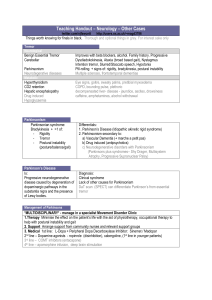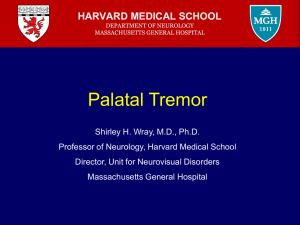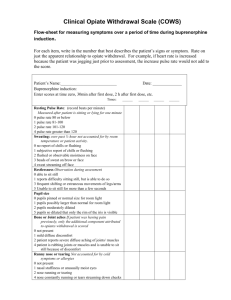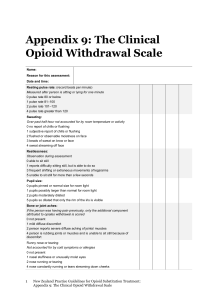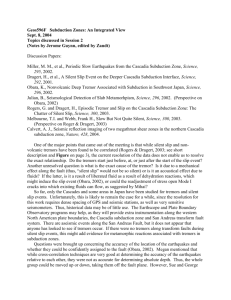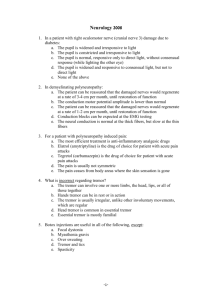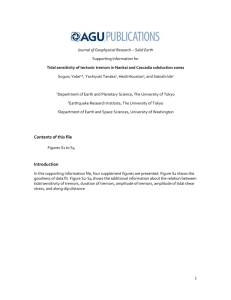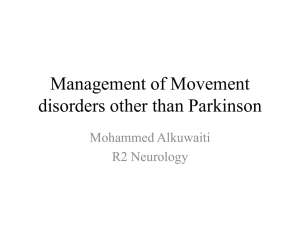Business Plan - Biomedical Engineering
advertisement
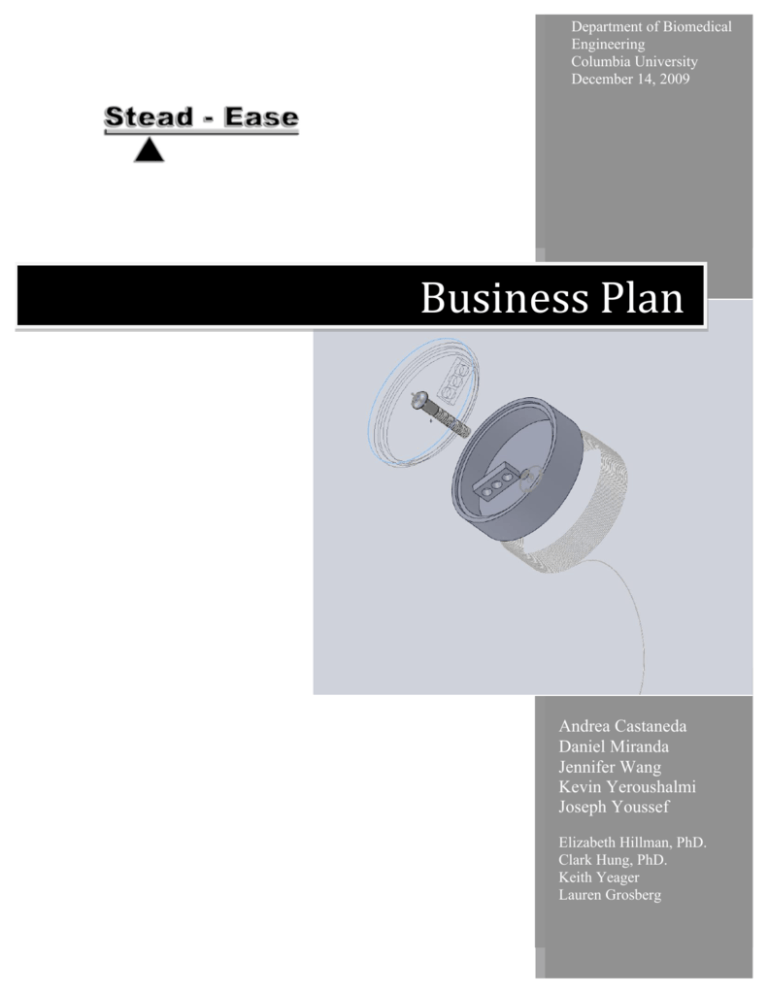
Department of Biomedical Engineering Columbia University December 14, 2009 Business Plan Andrea Castaneda Daniel Miranda Jennifer Wang Kevin Yeroushalmi Joseph Youssef Elizabeth Hillman, PhD. Clark Hung, PhD. Keith Yeager Lauren Grosberg Table of Contents Executive Summary....................................................................................................................3 Company Overview ....................................................................................................................4 Our Objective..........................................................................................................................4 Our Nearest Competitor ..........................................................................................................4 Our Product.............................................................................................................................4 The Market .................................................................................................................................5 Our Target Market ..................................................................................................................5 Our Customers ........................................................................................................................5 Reaching our Customers .........................................................................................................6 Our Competition .....................................................................................................................6 Key Forces in the Market ........................................................................................................6 Business Model...........................................................................................................................7 Sales and Distribution .............................................................................................................7 Strategic Partnerships..............................................................................................................7 Design and Development Plans...................................................................................................8 Financial Projections and Time-plan .........................................................................................10 2 Executive Summary In the United States alone a total of 5.5 million people suffer from Multiple Sclerosis (MS) or Essential Tremor (ET). These neurodegenerative conditions interfere with communication between the brain and motor neurons, effectively preventing those affected from controlling their movements. Over time the nerves deteriorate and the symptoms gradually worsen. 25-60% of MS patients and 95% of ET patients, totaling approximately 5 million people in the United States, experience unmanageable, erratic intention tremors in the arms, which are triggered or compounded by deliberate movements. As a result, this particular type of tremor makes daily activities such as eating, drinking, writing, typing, or driving difficult and, at times, embarrassing to accomplish. We offer a simple, long-lasting solution to the problems associated intention tremor in the arms. Our device, Stead-Ease 1.0, will target and successfully reduce these tremors so that users can perform a wide range of simple daily tasks with greater ease. This, in turn, will significantly increase the users’ health-related quality of life (HRQoL) as well as lessen embarrassment and need of assistance. The premise behind the design of our device is that mechanically dampening tremors in the arms by increasing resistance against gross movement will give users more control over their intentional movements, even when they are experiencing unintentional movements. The final product will be a user-friendly device that is inconspicuous, easy to operate, and effective. Our product will have a competitive advantage over others in several respects. It will be more versatile than other products in that it will be able to efficiently assist in multiple situations and accommodate most users. It will also be inconspicuous and avert unsolicited attention, restoring dignity and confidence in the user. The ultimate advantage of our device is its reliability, since it will accurately and immediately dampen tremors. We project that our target market is primarily comprised of the approximate 1.6 million MS and ET patients in the United States who would be interested in using, and are able to afford our device. Our market will also include institutions, such as hospitals, nursing homes, and physical therapy clinics, which will see the benefits of our device and want to make it available to their patients. We project that after year three of research and development and less than a year of initial sales we will reach the break-even point and progressively increase our net profit over time. We forecast a net profit of over $74 million within the first seven years of sales stemming from just Stead Ease 1.0. Future device development will generate new products that relieve a wider range of tremors, such as resting or physiological tremor. This will then allow us to expand our market to include surgeons, industrial and military personnel, and patients with Parkinson’s disease who require vibration isolation or extreme steadiness. We are a diverse group of senior undergraduate students in the Department of Biomedical Engineering at Columbia University. Our expertise spans from biomedical imaging to biomechanics to cell and tissue engineering. We work under the close advisement of several 3 committed faculty members as well as experienced physicians in the field of neurological disorders. We are dedicated to using our resources and knowledge to develop and produce devices to positively impact the lives of those affected by tremors. Company Overview Our Objective Stead-Ease engineers are working to alleviate the inconveniences suffered by the ever increasing population of patients with tremors. We design devices that help patients accomplish everyday tasks that otherwise would not be impossible. Our company aims to create a portable, easy-to-use device that will aid patients with ET and MS by dampening tremors significantly. Our main goal is for customers to be satisfied with the products they purchase from us which will forge lasting customer relationships. We will be able to target a large portion of the available market because current solutions do not effectively reduce tremor while remaining inconspicuous and simple, like our product will. Our Nearest Competitor Current tremor solutions include medications and surgical procedures which are simply inadequate because they are impractical, invasive, or specific to a certain activity. Devices such as the Neater Eater and the Thomas Steady Arm are device currently available and marketed towards people with tremors and other movement disorders. Their effectiveness is negated by their impracticality as these devices must be positioned in the place where they will be used. These table top devices restrict customer use to a certain area of their home or workplace. Simpler devices such as weighted eating utensils are also available. However, these devices only help with specific tasks and leave other difficult tasks unassisted. Lastly, Deep Brain Stimulation (DBS) is an option. Not only is it an invasive procedure, but positive results are not guaranteed for all types of tremor. In cases where positive results are attained, retention time is not high. DBS may be a concern for future competition, however, because as technology advances, the accuracy that DBS may provide will be able to compete with our future devices. Our Product Stead-Ease 1.0 is an arm brace that has a built in dampening mechanism which is triggered upon by the onset of a tremor. Once a tremor is detected through the use of accelerometers and goniometers working in conjunction, a signal will be sent to the dampening mechanism so that the effects of the tremor will be reduced and consumers will better be able to focus their movements. The dampening mechanism will be located at the elbow where a hinge will be positioned. The hinge will contain a fluid whose viscosity will vary depending on the presence of a tremor or not. The device as a whole will have beams extending from the elbow to equally distribute the dampening and overall steady the arm. After prototyping, we will arrive at our final market product with which we will conduct clinical trials to test patient interest and relevance. We will then be able to refine our device based on feedback and be able to begin sales and distribution, which will occur approximately three years after the beginning of research. 4 Our Future We plan to continue developing products that reduce tremor and allow our customers to focus their actions better. Later generations of our device will allow for the expansion of our target market due to advancement in technology. We aim to have our devices used in various applications from surgery to handcrafting, as long as consumers feel that they need a steadier arm to accomplish their tasks. We plan to expand to a more specific feedback system, as well as the dampening of smaller amplitude-higher frequency tremors. In the end, our customers are our number one priority and we plan to continue developing quality products that consumers will continually invest in. The Market Our Target Market The potential market for our proposed tremor-dampening device includes anyone who experiences intention tremors. This consists of the approximately 5.5 million patients with MS or ET, who experience involuntary movement in the upper limbs, which hinder voluntary motion or cause discomfort or embarrassment. Our Customers Our market projections indicate that we will have approximately 1.6 million potential customers. This niche market consists of patients with MS and ET who are under the age of 65 and have an annual household income of over $50,000. These patients are most likely to have a more active lifestyle, have fewer health complications, and be able to afford our device without insurance. Considering our product will be priced at $1000, we estimate that families with a combined annual income of $50,000 or greater would be able to afford our device. According to the Census Bureau, in 2008 approximately 43% of the American population earned an annual 5 household income over $50,0001. Based on income and age, we conclude that approximately 155,000 MS patients and 1.5 million ET patients will be both willing and able to purchase our product. Reaching our Customers Although our primary form of communication with our customer will be through our website, we will expand our network through other means of communication. For instance, we plan to advertise our product in commonly read special interest magazines, medical journals, and newsletters, such as the Ability Magazine and the MS LifeLines Magazine. Additionally, we will meet with physicians and physical therapists at conferences to sell them on the benefits of our product. Furthermore, our sales force will contact individuals, organizations, and institutions to market our device. Our Competition Our competition consists of other assistive device companies that provide similar solutions for tremors, including simple arm braces and task-specific aids, as well as pharmaceutical companies that develop drugs that could effectively reduce tremors. However, our major competitors focus on developing task-specific devices, whereas our device focuses on dampening tremor for multiple tasks. For instance, the Neater Eater and the Thomas Steady Arm have been proven to be relatively efficient for eating and drinking, but have shown poor results for writing and typing. Additionally, these competitors offer bulky, stationary devices, whereas our novel design is completely portable and lightweight. Furthermore, our device is less expensive than some of these competitor devices. The larger threat that we face is the pharmaceutical industry. Scientists and researchers have been working tirelessly to develop a more effective drug to combat these neurodegenerative diseases. However, current therapeutic drugs have limited effectiveness and tend to wear off after a limited time. Our product avoids the use of drugs and provides constant, reliable support for our patient. Key Forces in the Market The bargaining power of suppliers is the most pertinent force in the rivalry among our company and other existing competitors. Since most competitor dampening solutions have been established for several years, they will most likely garner more established relationships with wholesale raw material manufacturers. These competitors have a better likelihood of obtaining raw materials for discounted prices. With this advantage, our competitors may undercut prices to capture a larger portion of the market share. Based on the demand of the customers, our larger competitors can manipulate the market to drop the price of their motion dampening devices. If the price is altered too much, and we maintain our current price, we will lose a significant 1 U.S. Census Bureau, 2008. 6 portion of our potential market. On the other hand, if we give in to market pressure and decrease the price of our device, we will lose profits and this could end up being costly. Business Model Sales and Distribution We plan or making some of our sales transactions through a web interface, and some of our sales will come from direct-sales in medical facilities. On the website, users will be able to request a free informational packet including a pamphlet and an instructional/ promotional DVD. The online market will be offered a 30-day 100% money-back guarantee in case they order the incorrect size/calibration. Hospitals will be able to purchase Stead-Ease 1.0 in bulk for a discount (15% off 5+units, 25% off 20+units). The hospitals, in turn, will be able to re-sell our product to patients or provide their patients with a rental or lease-to-own option. A vendor approval system will be set in place in order to limit re-seller markup and ensure that warranties are properly transferred from hospital to patient in the event of a sale. The devices will all be individually packaged. Both online orders and hospital bulk orders will be processed in-house and shipped via UPS. Strategic Partnerships We plan on forming strategic partnerships with specialized medical institutions that cater to individuals with motor disabilities. This partnership will provide us with valuable market research in a controlled environment in exchange for discounted products. We will also form partnerships with our parts suppliers giving them rights to use our name and logo for promotional purposes in exchange for discounted materials. Parts and Service Contracts Our product will have both durable and non-durable components. The non-durable components, the arm straps and Velcro parts, are user serviceable. Everything else is considered a durable part. Non-durable parts will be covered under a one year warranty and users will be able to obtain factory replacements from us either online or through a liaison at their local medical center. Durable parts will be covered by a one year warranty and users will be able to either send their device back to us to get serviced. We will offer an extended limited lifetime warranty for $100 that will protect non-durable parts for two years and durable parts for the life of the device. The warranties are non-transferable, and will have to be re-purchased for each device. Instruction Stead-Ease 1.0 will not require the use of training centers. In order to help our consumers properly use the device, we will employ interns to produce an instructional DVD demonstrating proper usage practices as well as how to replace the user-serviceable parts. The interns will also be responsible for generating an instructional pamphlet that describes and illustrates the same actions demonstrated in the DVD. 7 Manufacturing We will keep device components in stock, but each unit will require assembly and packing before being shipped out. All assembly and packing will be done by hand in the same area that all the components are kept. The product will be packaged in a normal brown box with a cardboard insert made to securely hold the device. The consumer’s out-of-box experience will be similar to that of a cell phone in that the device will be displayed upon opening New Products Our company plans to continually improve our device and release new models or components on a yearly basis. Consumers will be able to trade in their current model and pay a discounted price for the newer model. The trade in value of each device is predetermined based on what model year it is, but is subject to revocation based on the devices operating condition. If no new model is developed, but a new component is developed, the consumers will have the option of purchasing a factory installed upgrade. Design and Development Plans Short term Stead-Ease is currently in the design and prototyping stage of production. We aim to have a working prototype by June 2010 and a marketable prototype by the end of the summer. In order to achieve this goal we must focus our development on three different parts of our device. First is the tremor detection unit. We plan on using a combination of accelerometers and goniometers to build a working prototype that will capture information and enable the control unit to detect a tremor. Should this method of tremor detection not work, we plan to try EMG sensors that will detect the firing of target muscle groups. When they fire at a certain rate, tremors will be detected and the device will then activate the dampening mechanism. During prototyping, our control unit will consist of a computer sending signals to our dampening mechanism. The computer will analyze the data coming in from the sensors and detect a tremor. The control unit in our final prototype will be further developed and we plan to use an arduino so that the device is easily mobile as planned. This prototype will guarantee that our final device will be able to detect the tremors that we are targeting no matter what solution we use to dampen. Concurrently, we will prototype the dampening mechanism which will depend on the signal sent to it from the control unit in order to start dampening. We plan to use a hinge filled with magnetic-rheological (MR) fluid. The control unit will send a digital signal that will induce a current in a solenoid located around the hinge. This induced current will create a magnetic field in the MR fluid, thereby, changing the viscosity. This will alter the force necessary to rotate the hinge and will reduce the oscillatory motions associated with intention tremors. Lastly we plan to design a sleeve that will combine all prototypes. Bars will extend from the dampening mechanism up the arm and along the forearm. This way any tremor propagating through the arm will be dampened from the center of the dampening mechanism. This sleeve will 8 hold the bars to the arm but will also have an even covering over the entire device to avoid tampering and obstruction from outside objects as well as ensuring aesthetic appeal. We will test our device by inducing involuntary periodic movement with a transcutaneous electrical nerve stimulator (TENS) unit. Testing, while attached and not attached to the TENS unit, will include raising a cup of water in order to test amount of water spilled, as well as tracing a circle and measuring variance. Results from both trials will be compared and the effect of tremor dampening will be able to be determined. Final Prototype (as seen under cover sleeve) Expanded Hinge Long term Depending on results attained from initial prototyping we will move forward with the final development of our product. We will receive SBIR funding and plan on doing clinical testing with our final prototype. In this way we will be able to get clinical feedback and support as well as start raising awareness of our product amongst our target market. Depending on our final model and whether we use an EMG based detection system, we will have to apply for FDA approval rather than just an FDA review of our device, as in the case of a purely mechanical device. After analyzing feedback from patients and doctors, we will continue to refine our device and plan on having initial distribution occur in early 2013. Our company will continually grow at this point, as sales and marketing efforts are increased. Product research will continue while our first product is released so that we can reach out to larger markets later on. Our device is an improvement upon current devices in many regards, but it still is not a complete replica of a tremor-less arm. We hope to develop further devices that address the drawbacks of our device. Future aims include development of a device that also rotates with the arm, and even more specifically the elbow. Our first device may inhibit motion in directions not parallel to the shoulder-elbow axis. We also plan on further developing our feedback mechanism so that users do not have to shut off the device manually. In further generations of our device we also plan to appeal to larger markets including occupations which require steadiness beyond the normal physiological tremor. 9 Financial Projections and Time-plan Venture capital funding and small business loans will allow for set up of our company in late 2012. Subsequently, sales of our first model will begin in 2013, at a price of $1000. With returns from our product sales and warranty memberships, we forecast our company will hit the break-even point midway through 2014 and will reach $10 million in net profit by 2016, at which point we could sell out. These figures are estimates based on how much of the market we will capture, the costs we incur, and the general spending habits of startup biotech companies. Our revenue stream is based on the units sold as well as warranties that are purchased. We estimate that we will gain between 0.2-0.6% of the market annually in a market that is growing at 0.3% every year with a base of 1.6 million potential customers. Our biggest costs include raw materials, which we estimate to be $200 per Stead Ease 1.0 unit and the debt repayment on the business loan. However, other costs include research and development which is estimated to cost approximately 9.6%2 of revenue, as well as information technology estimated at 2%3 of revenue, and advertising at 5%4 of revenue. Our last variable cost is warranty claims, which we will set aside 1.82%5 of revenue for, and is estimated based on the average rate set aside by 900 American manufactures. Other costs include workers’ compensation, utilities, rent, and patent fees and are outlined further in the tables below. 2 "Assistive Technology ‐ Trends in R&D Expenditures & Funding." U. S. Bureau of Industry and Security. Web. 14 Dec.2009.<http://www.bis.doc.gov/defenseindustrialbaseprograms/osies/defmarketresearchrpts/assisttechrept/2 2_trendsnr&d.htm>. 3 "Manage IT as a percent of revenue to relate to your CEO." TechRepublic Articles. Web. 14 Dec. 2009. <http://articles.techrepublic.com.com/5100‐10878_11‐1038684.html>. 4 What Should You Spend on Advertising? ‐ BusinessWeek." BusinessWeek ‐ Business News, Stock Market & FinancialAdvice.Web.14Dec.2009.<http://www.businessweek.com/smallbiz/content/feb2009/sb20090210_16549 8.htm>. 5 "Warranty Week, Warranty Reserves and Accruals, 10 May 2006." Warranty Week ‐ the Newsletter for Warranty Management Professionals. Web. 14 Dec. 2009. <http://www.warrantyweek.com/archive/ww20060509.html>. 10 Table 1: Revenue Projections Table 2: Cost/Net Profit Projections Graph 1: Financial Projections 11

